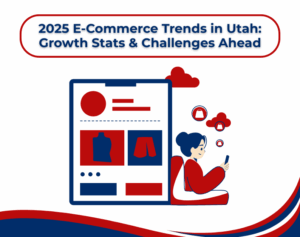2025 E-Commerce Trends in Utah: Growth Stats & Challenges Ahead

Utah’s economy has long been recognized for its innovation, entrepreneurial spirit, and tech-friendly climate. Over the past few years, e-commerce has become one of the state’s fastest-growing industries—fueled by a combination of strong local infrastructure, supportive policies, and a growing population of digital-first consumers. As we step into 2025, e-commerce in Utah continues to evolve rapidly, presenting exciting growth opportunities as well as new challenges for businesses.
This article explores the current state of e-commerce in Utah, highlights key trends, and unpacks the biggest obstacles facing online retailers in the state.
Utah’s E-Commerce Growth in 2025
Utah’s e-commerce sector has seen consistent double-digit growth since 2020. While the pandemic initially accelerated online shopping, consumer behavior has remained digitally focused—even as brick-and-mortar retail rebounded. In 2025, Utah continues to punch above its weight, with a robust blend of homegrown e-commerce brands, tech-savvy startups, and fulfillment infrastructure to match.
Key factors driving this growth include:
- A youthful, digitally native population
- Strong broadband access and mobile usage
- A thriving startup ecosystem in “Silicon Slopes”
- Supportive state and local government programs for small businesses and tech innovation
Cities like Salt Lake City, Provo, and Lehi are emerging as hubs for e-commerce operations, with several online brands expanding regionally and nationally from Utah.
The Rise of Utah-Based E-Commerce Brands
Utah is home to a growing number of successful direct-to-consumer (DTC) brands and e-commerce players in various industries—from health and wellness to outdoor gear and fashion.
Some trends we’re seeing in 2025:
- Growth in niche DTC brands using storytelling and influencer partnerships
- Subscription-based services expanding into health supplements, meal kits, and hobby products
- Local businesses using Shopify and other tools to scale nationally
- An increased focus on “Made in Utah” branding for authenticity and customer loyalty
These businesses are leveraging Utah’s creative talent, relatively low operational costs, and access to major shipping corridors to thrive in the competitive e-commerce space.
Key Technologies Fueling E-Commerce Innovation
Technology plays a vital role in the growth and competitiveness of e-commerce businesses in Utah. In 2025, several innovative tools and strategies are driving how local companies attract customers, streamline operations, and scale efficiently.
Current tech trends shaping the landscape include:
-
AI-powered product recommendations, chatbots, and SEO tools that personalize shopping experiences and improve discoverability
-
Mobile-first design, progressive web apps, and smart web design for seamless browsing across all devices
-
Automated inventory management and fulfillment systems to speed up delivery and reduce operational overhead
-
AR (augmented reality) integrations that allow customers to preview products virtually before purchasing
-
Advanced analytics platforms and social media marketing (Facebook, Instagram, TikTok, YouTube) to measure performance and amplify brand reach
With easy access to top-tier software talent, Utah-based e-commerce brands are often early adopters of emerging technologies, giving them a competitive edge nationwide.
Logistics & Fulfillment in Utah
Fast, reliable shipping remains a key success factor in e-commerce—and Utah is uniquely positioned to deliver. The state’s central location in the western U.S. allows for quick shipping to both coasts, and access to major interstate highways and distribution centers helps keep logistics costs low.
Many Utah businesses are utilizing:
- Third-party logistics (3PL) partners located throughout the Wasatch Front
- Local warehousing to offer same-day or next-day shipping across the region
- Fulfillment integrations with Amazon, FedEx, UPS, and Shopify Fulfillment Network
This logistics advantage makes Utah a strategic base for e-commerce expansion.
Major Challenges Facing Utah E-Commerce in 2025
Despite rapid growth, the industry faces a variety of hurdles in 2025.
Increasing Competition
The e-commerce space is more saturated than ever. Small businesses in Utah must compete not only with national giants like Amazon but also with other agile, well-funded startups. Standing out requires sharper branding, superior customer experience, and highly targeted marketing strategies.
Rising Customer Expectations
Consumers in 2025 expect seamless, fast, and personalized shopping experiences. Delays, poor website performance, or lackluster service can quickly lead to lost sales and negative reviews. Businesses must continue investing in user experience, customer support, and backend systems to keep up.
Data Privacy & Compliance
New state and federal regulations around consumer data and online privacy are impacting how Utah e-commerce businesses collect, store, and use information. Compliance with laws like the Utah Consumer Privacy Act (UCPA) is essential for avoiding penalties and maintaining customer trust.
Talent Shortages
While Utah is rich in tech talent, the rapid growth of the industry has created high demand for digital marketers, developers, and logistics professionals. Smaller companies may struggle to attract or retain skilled employees, especially in rural areas.
Managing Returns & Customer Service
As online sales rise, so do returns and customer support inquiries. Handling returns efficiently—while maintaining profit margins—remains one of the biggest challenges for Utah-based retailers. Strong customer service tools and clear return policies are critical to brand loyalty.
Opportunities for Future Growth
Despite the challenges, the future of e-commerce in Utah looks promising. Businesses that embrace innovation and agility will continue to thrive.
Opportunities include:
- Expanding internationally via cross-border e-commerce platforms
- Launching mobile-first or app-based retail experiences
- Using influencer marketing to tap into national audiences
- Leveraging Utah’s lifestyle and outdoor culture to build strong niche brands
- Partnering with local universities for research, interns, and digital training
As consumer behavior continues to evolve, Utah’s businesses are well-positioned to lead the next wave of digital commerce innovation.
Final Thoughts
In 2025, Utah’s e-commerce industry is a powerful engine of growth, innovation, and opportunity. From startups in Lehi to gear companies in Ogden, the state is proving that geography is no limitation to digital success. While challenges like competition, regulation, and logistics persist, Utah’s business-friendly climate and culture of entrepreneurship offer a strong foundation.
To stay competitive, local e-commerce companies must stay nimble, invest in digital tools, and continuously optimize their online presence. Those who do will not only ride the e-commerce wave—but help shape the future of it in the Mountain West and beyond.




